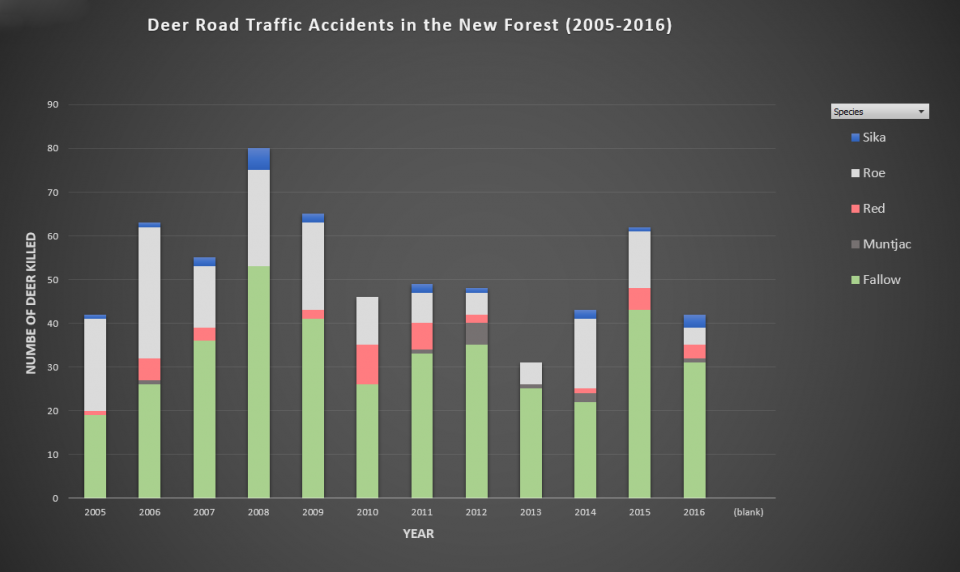Deer (Overview) Interaction with Humans - Vehicle Collisions
Road traffic accidents involving deer seem to be a growing problem. Unfortunately, there are no recent data, but according to a study published in October 2001 by the Deer Commission for Scotland, some 300 people are killed and 30,000 injured in collisions with hoofed game across Europe each year. In the UK, it is estimated that there are about 200 accidents involving deer every day and 20 people are killed per year. In 2007, the Deer Initiative in conjunction with the Highways Agency published their Deer On Our Roads survey results.

Between January and December 2005, there were more than 30,500 reports of deer-vehicle collisions (DVCs) in Britain, of which nearly 25,000 (82%) occurred in England. Disturbingly, the report concluded that these records make up only a small percentage (perhaps only 20%) of the actual DVCs nationwide and that the true figure for Britain may exceed 74,000. Indeed, in his Fauna Britannica, Hart-Davis points out that it is almost impossible to quantify the total number of deer killed on the roads, because many disappear in the boots of cars!
In England, the report found that Fallow were involved in 40% of the DVCs, with Roe hit in 32% of cases and muntjac in 25% - Red, Sika and water deer contributed less than 3% combined. In an article to Surveyor magazine during October of 2004, Alexandra Wilson and Jochen Langbein note that:
“The annual cost of car repairs alone, over and above losses associated with human injury costs from such [DVC] incidents, is estimated to exceed £11m [US$17.5m or €12.6m]”.

As might be expected, there are certain locations and conditions under which a collision with a deer is more likely to occur. The Deer Initiative’s study found that DVCs were most common in Southern England and, between 2003 and 2005, there were more than 75 per 5km (3.5 miles) stretch of “hotspot” road in this region – some of the worst places for DVCs included Southampton and Portsmouth in Hampshire. Personally, I have observed a considerable number of muntjac killed along the A12 in East Anglia. Collisions with Fallow and Red deer were more likely to happen between October and January and the peak time for DVCs was from early evening (about 6pm) until midnight and then again corresponding to the morning rush-hour (6am to 9am).
A study published in the German journal Tierarztliche Umschau found that more accidents involving Roe deer in North-west Germany occurred on dull days, with an increase in the number of such days making December one of the worst months for road traffic accidents involving deer. More recently, in a paper published in Biodiversity and Conservation during 2018, a team of zoologists, led by Victor Colino-Rabanal at Salamanca University, analysed just over 11,000 records of collisions between cars and three ungulate species (wild boar, Sus scrofa; red deer, Cervus elaphus; and roe deer, Capreolus capreolus) in Spain and one (white-tailed deer, Odocoileus virginianus) in New York State. For all species the peak time for collision was at dawn and dusk, but most interestingly three of the four showed a very strong correlation with lunar phase. Wild boar, roe deer and white-tailed deer were all most likely to be involved in accidents during full moons and least during new moons. This relationship was particularly prominent for roe deer, with full moons increasing the likelihood of a vehicle collision by 71%. We lack sufficient data on deer ranging studies to properly understand what causes this relationship; but the authors do point to the possibility that moon brightness may also affect driver behaviour.
Much work has been done with the goal of finding methods of reducing the number of DVCs worldwide – these have included reflective posts by the roadside, acoustic alarms triggered by headlights and ultrasonic whistles attached to cars. The results have been mixed and, in the case of some designs of deer whistles, there is debate as to how effective they are likely to be given what we know about deer hearing.
Cars aside, crop mowers represent an important mortality factor for some deer species. A study by Anders Jarnemo, published in the journal Wildlife Biology, looked at the mortality rates of Roe kids on intensively farmed land in Sweden. Jarnemo, a biologist at the Swedish University of Agricultural Science, found that between 1997 and 1999 25% to 44% of the yearly recruitment of Roe deer was killed by mowers. Susceptibility continued until the kids were at least one month old. Jarnemo also found that putting a black plastic sack on a two metre (6ft) pole into a field set to be mown resulted in the mothers moving 21 out of the 22 kids bedded there by the second day, thereby minimizing mortality. Sharon Scott, who runs manages a farm in Buckinghamshire with her husband Graham, tells me she has to walk in front of the combine harvester every summer to move Chinese water deer and muntjac fawns left in the fields while their mothers are off foraging.